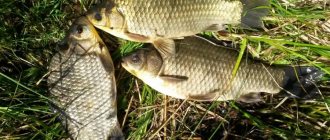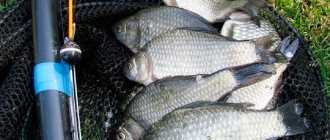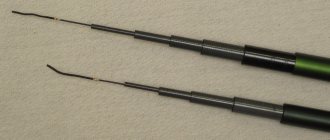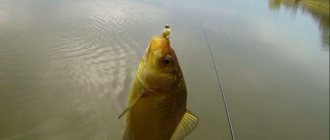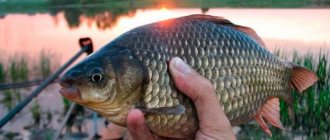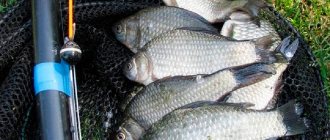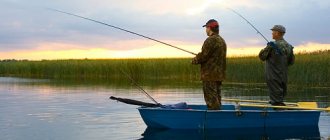“Equipment of a float rod for crucian carp.” Crucian carp is the most common “peaceful” fish that lives in almost all bodies of water.
“This is what crucian carp looks like”
They catch it with a variety of gear, but the most effective way is to catch crucian carp using a float rod.
The gear, familiar from childhood, allows you to effectively catch the favorite stopping places of this fish - shallow areas with a muddy bottom, replete with underwater vegetation.
To catch crucian carp, you need to have the right gear. There are no trifles in this fishing, so we will dwell in detail on the choice of each element of gear.
Equipment for a float rod for crucian carp - Rod
At the moment, there are several types of fishing rods for float fishing: plug, match, fly and Bolognese fishing rods. Plug and match gear is overkill.
"Deaf Fishing Rod"
The former cost incredible amounts of money, and match fishing rods designed for long-distance casting are simply irrelevant, because this very long cast is simply not needed when fishing for crucian carp - crucian carp is perfectly caught at a short distance from the shore, sometimes almost “under your feet.”
But fly rods (blind equipment) and Bolognese rods (with guides and a reel) are simply perfect for our tasks.
What's better? You can hear different opinions on this matter. Personally, I am inclined to believe that it is more rational to use Bolognese rods for catching crucian carp.
The Bolognese fishing rod is much more practical than the fly fishing rod. If only because you can wind a large amount of fishing line onto the reel, and if the equipment breaks or gets tangled, you can quickly unwind the required piece of fishing line and quickly re-equip the fishing rod.
If the equipment on the fly rod breaks, re-equipment takes much more time. Another advantage is that you can unwind exactly as much fishing line as you need for comfortable fishing in certain conditions. If, for example, the depth at the fishing spot is great, and the fish is 5-7 meters from the shore, it is more convenient to fish with a fishing line that is about a meter long than the fishing rod.
But if the cool spot is in a window among the algae, which is only about 3-4 meters away, it is better to make the fishing line shorter, because The casting will always be accurate and, importantly, quiet.
You should not buy long 5-6 meter rods. Their advantages are extremely doubtful, but the inconveniences are obvious. They are heavy, uncomfortable, and catching them by hand is a real pain.
A four-meter telescopic fishing rod is the optimal tackle for catching crucian carp. There are plenty of rods of this kind on sale, so there shouldn’t be any problems with the choice.
If possible, I recommend purchasing a carbon fiber fishing rod. It costs much more than fiberglass. But it is lighter, and the thrill of fishing for crucian carp on clear carbon cannot be compared with fishing on glass.
How to make tackle for catching crucian carp using a float rod
We will consider making gear on a sliding float. This installation will help deliver your bait over long distances.
There is nothing particularly difficult in making gear. And when they ask you how to make tackle for catching crucian carp with a float rod? Answer boldly, easily. To do this, it is necessary to highlight several significant nuances and that’s it, the tackle is almost ready.
A locking knot is used to adjust the depth; this method is suitable if you plan to fish in one place for a long time and the depth there does not change. If the fishing depth changes, it is recommended to use rubber stops. There is one big drawback: when casting, the stoppers cling to the rings and you are unlikely to be able to cast far.
Therefore, we will consider installing a locking unit for a sliding float. It does not interfere with casting and slips through the guides. To tie such a van knot you will need 15 centimeters of fishing line, the same as the main one. Instructions for tying a stop knot for a float tackle are provided in the picture below.
Some fishermen tie a knot using insulated wire or a plastic tube; they say it’s more convenient, but I haven’t personally tested it. You can check it and write your opinion about this in the comments. Then the main fishing line is threaded onto this tube and a knot is pulled onto the fishing line, similar to the scheme for putting on a silicone stopper.
They say that the knot must be wetted before tightening. Supposedly this helps to avoid deformation of the fishing line, but I have never done this and nothing has become deformed. The ends of the knot should not be cut off at the very edge, leave 3 centimeters each, they will not interfere, and the knot will be more reliable.
Better to see once than hear a hundred times. I suggest you watch a video on how to make tackle for catching crucian carp using a float rod. It shows in detail the scheme for tying a stopper knot and discusses the main points in this process.
The main difficulty in making the tackle is tying the stop knot, but now that it is tied you are left with the simplest thing. We pass a swivel through the main line, to which we will then attach a float. The swivels help the float to slide freely along the line without damaging it.
Now you have to choose which weight to use. In the case of using a sliding sinker (for example, in the shape of an olive), it must be threaded immediately behind the swivel. There are no problems with putting on weights in the form of pellets; they can be put on after installing the equipment.
Now we tie a loop at the end of the fishing line for attaching leashes or a swivel. Whichever is more convenient, I prefer a loop. You can read below about how to attach hooks.
Equipment for a float rod for crucian carp - Reel
There is no need to complicate things here. Buy the cheapest, simplest reel.
"Select Coil"
It is needed solely for storing fishing line; it is not involved in casting or retrieving in any way.
You can, of course, install a small inertia-free system, but the question arises: “Why?”
Why spend more money, why make the tackle heavier? That's right, there's no need.
So let’s continue to talk about what the equipment of a float rod for crucian carp should be.
In the snap-on "spring"
This kind of equipment is very often used when fishing for crucian carp. A “spring” is a feeder that is shaped like a spring. This is where this feeder got its name from. In such equipment there may be several leashes with a length of 5 to 7 cm. When using such equipment, many fishermen do not use bait, but stick bare hooks (or with foam) into the bait. The crucian carp sucks in the bait and along with it the hooks. Thus, the crucian carp ends up on the hook, and it is caught due to the weight of the feeder. If foam is used, the hooks float and are held in the water column. Why fish are caught on foam plastic is a secret to this day. For some reason, the crucian carp tries to remove inedible garbage away from the place where it wants to feed. He takes it in his mouth and tries to move it, after which he cuts himself. Monofilament fishing line with a thickness of 0.25-0.4 mm is used as the main fishing line, and braided fishing line with a diameter of 0.04-0.1 mm will be used as leashes.
Equipment for a float rod for crucian carp - Line
When choosing a fishing line, the main thing is to maintain a balance between strength and diameter.
“What is the best line to choose?”
There is always a temptation to use a very thin line, with a diameter of 0.12-0.14 mm, in order to make the tackle as delicate as possible.
But if a large crucian carp, or perhaps a carp or tench, is caught on the hook, such a thin fishing line simply will not withstand the pressure of the fish.
Therefore, it is better to play it safe and wind a fishing line with a diameter of 0.18-0.2 mm on the reel. Don't skimp on this piece of equipment. Buy high-quality, expensive fishing lines (can be unrolled 30-50 m).
Cheap products, unfortunately, often do not correspond to the characteristics stated on the packaging, and can fail at the most inopportune moment.
Bait for crucian carp
In order for the bite to be excellent, it is recommended to use bait.
It is better to use the following components for this:
- Garlic is the most important ingredient; crucian carp love it very much.
- wheat;
- Hercules;
- semolina;
- corn, including canned corn;
- chopped worms, especially earthworms and dung worms;
- dill;
- parsley and so on;
Key tips for preparing bait:
- Should be as natural as possible.
- A minimum of nutritional components (so as not to overfeed the fish).
- foreign ingredients and strong spices .
- Be extremely careful with adding artificial flavors.
It is better to feed little by little, otherwise the crucian carp may not bite at all.
flavorings
When choosing a flavor for bait, it is worth considering a number of points:
- It should be without a pungent odor.
- It is ideal to use natural oil , such as sunflower oil. Interesting fact: it has been noted that a good bite can be observed when the aroma of rye bread is present.
- The main thing is not to overdo it, otherwise you may scare the fish away.
Depending on the season, you need to use certain baits:
- In spring, give preference to steamed peas, semolina and rolled oats.
- In summer - wheat, sunflower seeds, and greens.
- In autumn and winter, be sure to add chopped worms or maggots.
In addition, depending on the reservoir, a special bait is also used:
- Features of bait on lakes and ponds:
- Do not cook the porridge until the end.
- Use sunflower oil (just a few drops).
- Be sure to add steamed wheat or peas. If the crucian carp ignored the bait, then it is recommended to replace the composition of the ingredients with another one.
- Feeding is allowed every hour.
- Features of feeding river fish:
- Add more garlic.
- It is better to use semolina or wheat as a base.
- Feed no more than once every two hours, and in small portions.
Important advice: in each region it is noted that such fish has its own preferences, so it is better to experiment.
Float
The bites of crucian carp are very careful, and to notice them you need a sensitive float.
"Selection of float"
The best floats in this regard are made from goose feathers, or floats in the form of thin, hollow “sticks” made of plastic.
Their advantage over floats with a voluminous body is also that they offer virtually no resistance in the water, which can scare away the crucian carp who decides to taste your bait.
I usually fix goose feather floats on the fishing line using cambrics of the required diameter.
You can make them yourself (by cutting braided electrical wires or a medical pipette), or buy them ready-made at a fishing store.
Why do you need a leash when fishing for crucian carp?
Crucian carp is a rather shy and cautious fish. It is not difficult to scare him away by the presence of a noticeable fishing line, even if all the preparatory processes are done correctly: the place is baited, and the place itself is quite promising. To prevent this from happening, you should be very responsible when choosing a leash. The most important thing is that the crucian carp cannot distinguish it from all the inhabitants of the underwater world, including vegetation. As a rule, a very thin fishing line is selected that matches the color of the bottom of the reservoir, the color of the water, as well as aquatic vegetation. This can make it almost invisible to the crucian carp, and he will take the bait without any fear. Recently, fluorocarbon has become very popular, although it is less durable and more rigid than fishing line. This factor should always be taken into account when making leashes.
Loading
Lead pellets are ideal for loading. The weight is selected so that the float is clearly visible, but at the same time there is no noticeable underload.
The pellets should be clamped on the fishing line so that they are well held on it, but with a certain force they can easily move up and down. This will make it possible to adjust the length of the leash and adapt to the mood of the fish.
Sometimes crucian carp takes the bait more boldly on a long leash, and in some cases it is necessary to reduce the distance from the hook to the weight (for example, to increase the percentage of realized bites).
What fishing line should you use and what thickness?
Crucian carp requires very sensitive equipment. Such sensitive equipment is an asymmetrical loop. It is possible to use a less sensitive asymmetrical loop. The easiest to install is the paternoster and it can also be used when fishing for crucian carp. As the main fishing line you need to take a braided line with a thickness of 0.1 - 0.12 mm, and use a monofilament with a diameter of 0.14-0.16 mm as a leash. The length of the leash depends on the fishing conditions and can range from 0.5-1 m.
Where to catch large crucian carp
Representatives of the carp family are considered traditional inhabitants of freshwater reservoirs located in temperate climates. That is why an angler can easily find them in almost any lake, river, etc. However, it is not possible to catch a really large crucian carp in every place; for this, special conditions and microclimate must be formed.
Important! Crucian carp is not found in mountain reservoirs.
Its traditional habitat is considered to be reservoirs located in the lowlands or on the plain, and especially in swampy areas. The main one is the size of the reservoir, because only in a large river or lake is the necessary food supply and living space formed. In addition, depth is an important factor.
For the successful growth and development of large specimens, the water layer from the bottom to the surface must be at least 3–4 m, so you need to find the optimal place long before you go fishing. In this case, such fish most often live:
- at a distance of 10–15 m from the shore;
- in bays with dense vegetation;
- near underwater holes and edges;
- near flooded trees or snags.
